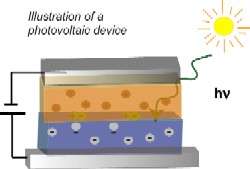Chemists Identify New Way to Create Photovoltaic Devices

(�鶹��ԺOrg.com) -- A promising new polymer-based method for creating photovoltaic devices, which convert sunlight into electricity, has been identified by chemists at the University of Massachusetts Amherst. Their new technique should lead to more efficient power production than achievable by the current generation of semiconductors.
The work by Sankaran Thayumanavan and colleagues at UMass Amherst, with others at the University of California-Riverside, is highlighted in the current issue of the Journal of the American Chemical Society (JACS), a premier chemistry journal, for the clever way it mimics nature’s way of harnessing solar energy.
To achieve the breakthrough, Thayumanavan and co-workers took inspiration from plants and experimented with organic molecules to mimic the photosynthetic machinery of plants. Their new paper demonstrates how a photosynthesis-style photovoltaic device can be designed using large, highly branched, non-biological organic molecules called dendrimers, based on plant anatomy. Branches allow the dendrimer to absorb photons from a wide area and funnel this energy to the dendrimer’s core where it is connected to a polymer “wire.” At the core, charge is separated and the electrons travel down the polymer “wire” to an electrode where electricity is produced.
As Thayumanavan explains, “Our method is inspired by an energy-harnessing process that plants use in nature, which evolved over millions of years to be efficient in terms of capturing a lot of energy and transporting it short distances without power loss. In the future, photovoltaic devices may no longer rely on slower, less efficient human-made semiconductors. Our work should lead to lighter, more efficient and sustainable photovoltaics.” Thayumanavan, known to colleagues as “Thai,” is director of the UMass Amherst’s Fueling the Future Center for Chemical Innovation.
He adds, “The hope is that such a bio-inspired design could approach the conversion efficiency that plants achieve naturally.”
The recent JACS article by him and colleagues titled, “Dendritic and linear macromolecular architectures for photovoltaics: A photoinduced charge transfer investigation,” was selected by the journal editors to appear in a special section, “Harnessing Energy for a Sustainable World.” They predict that the research will transform the way engineers design future photovoltaic devices.
The editors add, “Innovation through scientific discovery is a necessary component of much societal advancement. To truly implement sustainable practices, energy must be harnessed more cleanly and stored for efficient distribution and use. This systems-level change sometimes referred to as the New Industrial Revolution, will require novel materials as well as savvy analysis and modeling to ensure success.”
More information: Paper:
Provided by University of Massachusetts Amherst
















